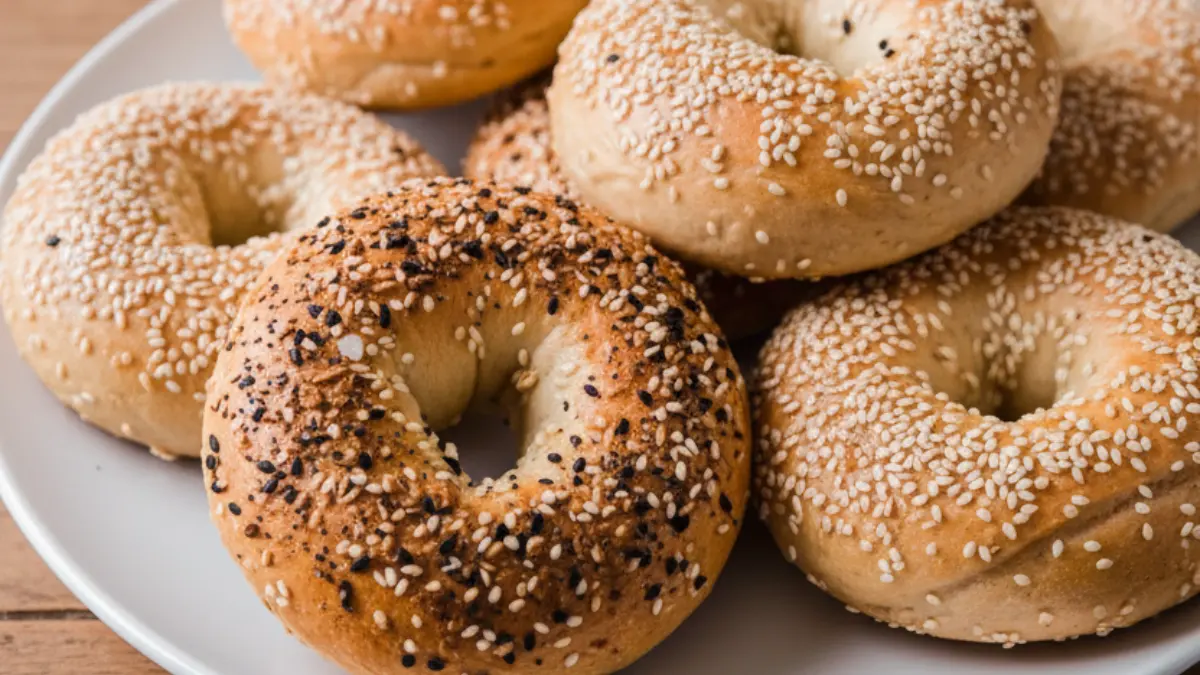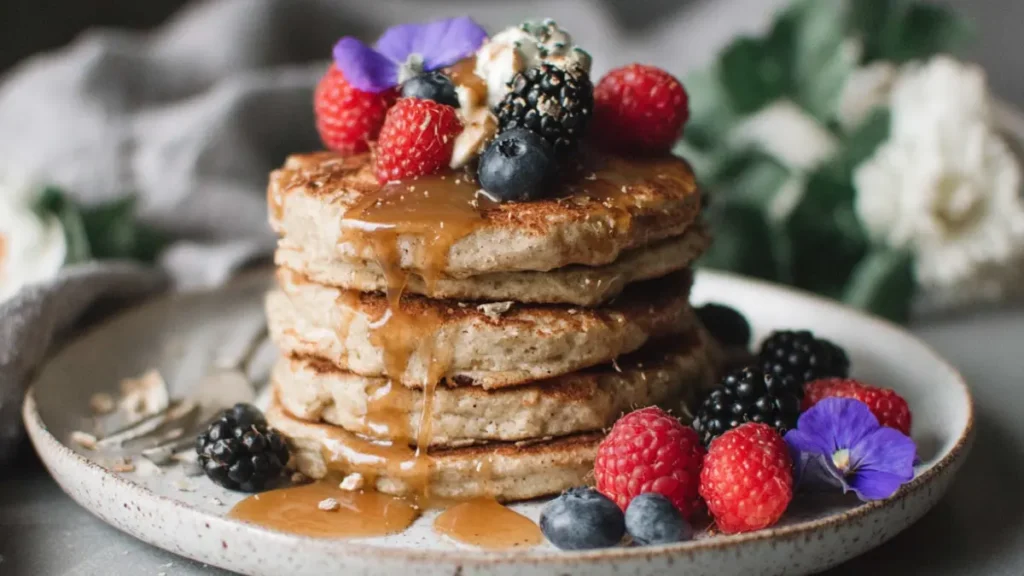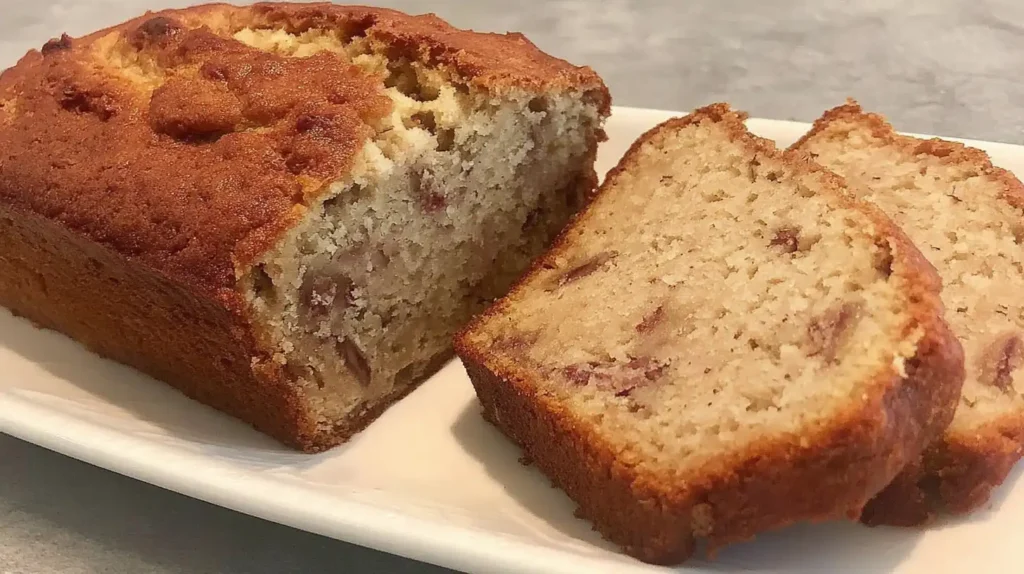If you’ve ever reached for a chewy New York bagel and thought, “Delicious… but where’s the protein?” – you’re not alone. That’s exactly why protein bagels have exploded from TikTok trend to breakfast staple. They promise the comfort of a bagel with the muscle-fueling boost of Greek yogurt, cottage cheese, or even protein powder.
Here’s the honest part, though: not every protein bagel recipe delivers. Some turn gummy in the center, others dry out like hockey pucks, and a few barely nudge the protein count past your average slice of bread. Frustrating, right? That’s why I set out to test – and retest – three different versions until I found the sweet spot where taste, texture, and macros finally balance out.
In this guide, you’ll learn:
- The Greek yogurt method (quick, 5 ingredients, no yeast).
- The cottage cheese method (softer crumb, higher protein).
- The protein powder boost (max macros without turning chalky).
And because the internet is a battlefield of conflicting advice – bake vs air fry, yeast vs no yeast, to boil or not to boil – we’ll compare them all side by side. I’ll show you oven and air fryer instructions with exact times, plus troubleshooting for the mistakes everyone makes (yes, even me on the first round).
Think of this as the only protein bagel playbook you’ll need – whether you want a 10-minute fix before work, a freezer stash for the week, or a classic chewy upgrade that tastes closer to the real deal.
Protein Bagel Recipe – Quick Overview & Which Version to Choose
Not all protein bagels are built the same. Some lean light and tangy, others richer and softer, and a few pack nearly double the protein thanks to a little help from whey. Before diving into grams and steps, here’s how to choose the right protein bagel recipe for you.
Greek Yogurt Bagels (The Classic Shortcut)
This is the viral version you’ve probably seen – just flour, Greek yogurt, baking powder, salt, and an egg wash. They’re quick, only need one bowl, and clock in around 10–11g protein each. The trade-off? A little less chew, and texture can shift depending on your yogurt’s thickness.
Cottage Cheese Bagels (Softer + Higher Protein)
Blend cottage cheese into the dough and you’ll hit 11–13g protein per bagel, with a fluffier, almost tender crumb. They’re forgiving if you overbake slightly and reheat beautifully from the freezer. Ideal if you want a softer bite or naturally creamier flavor.
Protein Powder Bagels (Max Macro Boost)
If you’re chasing numbers, this is your lane. By adding whey isolate or a whey/casein blend, you can push bagels into the 15–19g protein range. The challenge is balancing hydration so they don’t dry out or turn rubbery – but I’ll show you the tested ratios that work.
Best For:
- Busy mornings: Greek yogurt (5 ingredients, no fuss).
- Meal prep: Cottage cheese (freezer-friendly, soft crumb).
- Max protein: Whey-boosted (19g and still chewy if done right).
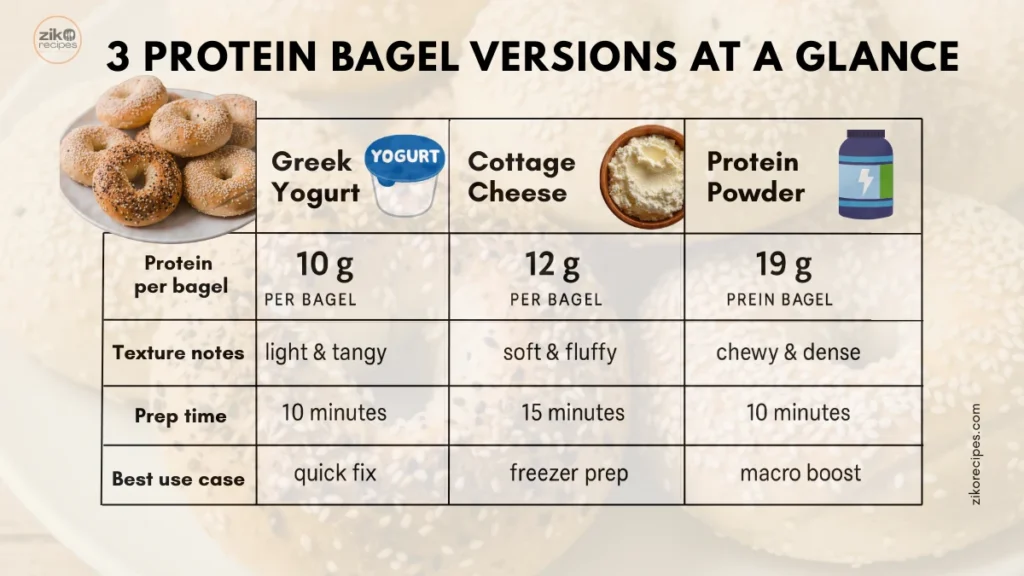
At-a-Glance Macros & Texture Notes
Here’s the quick snapshot you’d usually have to scroll for:
- Greek Yogurt: ~10–11g protein | Light crumb | Fast prep
- Cottage Cheese: ~11–13g protein | Fluffy crumb | Freezer friendly
- Protein Powder: ~15–19g protein | Dense chew | Higher effort
Ingredient Shortlist (What You Absolutely Need)
Across all versions, you’ll always need:
- A flour base (self-rising, or AP flour + baking powder + salt)
- A protein-rich dairy (Greek yogurt or cottage cheese) or whey isolate
- An egg wash (for sheen + seed adhesion)
Optional but recommended: toppings like everything bagel seasoning, sesame, or cinnamon-sugar for variety.
Greek Yogurt Protein Bagels (No-Yeast, 5 Ingredients)
If there’s one recipe that put protein bagels on the map, it’s the Greek yogurt version. Simple, fast, and surprisingly satisfying – these no-yeast bagels can go from mixing bowl to oven in under 30 minutes. With only 5 ingredients, they’re the perfect entry point if you’re new to high-protein baking.
The secret lies in the yogurt. Thick Greek yogurt adds not only protein but also acidity that activates the baking powder, giving you a light rise without the wait for yeast. But here’s the catch: not all yogurts behave the same. A watery brand will leave your dough sticky, while a super-thick one can make it crumble. I’ll show you how to adjust on the fly.
Step-by-Step Instructions (Oven & Air Fryer)

- Mix the base: Combine self-rising flour (or AP + baking powder + salt) with plain Greek yogurt. Start with a spatula, then switch to your hands once shaggy.
- Knead briefly: About 2 minutes – just until the dough comes together. Too much kneading = tough bagels.
- Shape into rings: Divide into equal pieces (a kitchen scale helps). Roll into ropes, pinch the ends, and smooth the seam.
- Egg wash & toppings: Brush lightly with beaten egg for shine. Sprinkle sesame, everything seasoning, or cinnamon sugar.
- Bake or air fry:
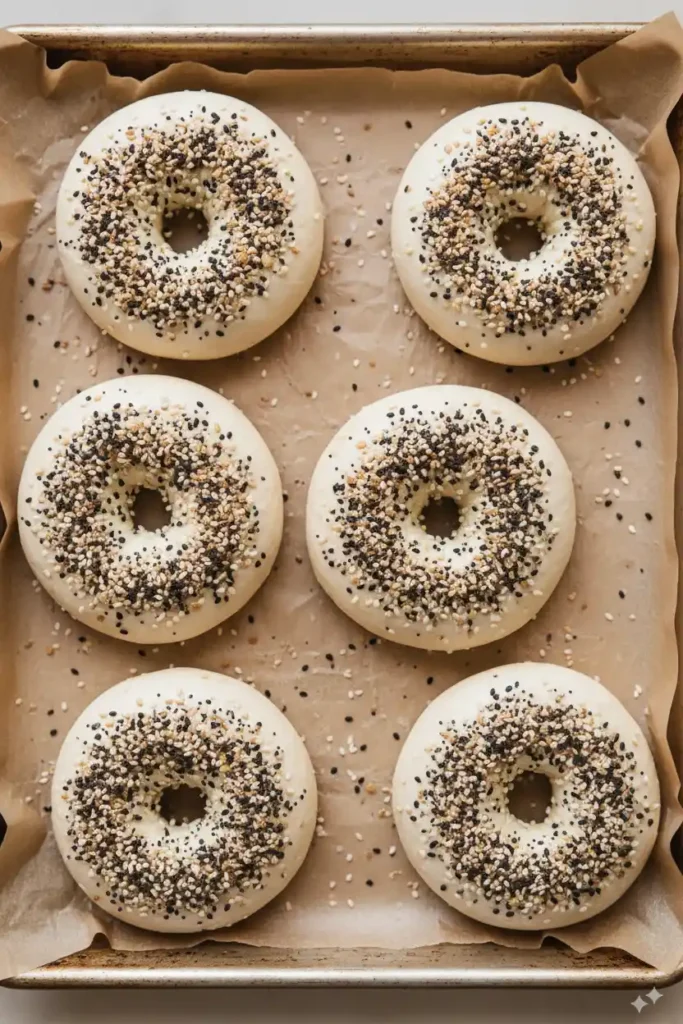
- Oven: 375°F (190°C), 20–25 minutes, until golden and firm to the tap.
- Air fryer: 300°F (150°C), 15–18 minutes. Flip halfway for even browning.
Pro tip: If the dough feels sticky, dust with a spoon of extra flour. Too dry? Drizzle in 1 tsp milk or water and knead lightly.
FAQ – Do Greek Yogurt Bagels Taste Like Regular Bagels?
Not exactly. Traditional bagels are yeasted and boiled, which gives them that signature chew. Greek yogurt bagels are lighter, a little tangier, and closer to a soft roll than a dense NY bagel. But for 10 minutes of hands-on time, they come impressively close – especially once toasted.
Cottage Cheese Protein Bagels (Ultra-Tender, 11g+)
If Greek yogurt bagels are the trend-setter, cottage cheese bagels are their softer, creamier cousin. By blending cottage cheese right into the dough, you add not only protein but also a natural tenderness that keeps the crumb moist even after a day or two. Each bagel lands around 11–13g of protein – slightly higher than the yogurt version – and the taste is subtler, less tangy.
The biggest win? These bagels freeze and reheat better than almost any other version. Toast them straight from the freezer and you’ll still get a fluffy, satisfying bite instead of a dry puck. For meal-preppers, that’s a serious advantage.
Step-by-Step Instructions (Oven & Air Fryer)
- Prep the base: Blend 1 cup (225g) cottage cheese until smooth. If yours is especially watery, strain for 10 minutes first – too much liquid will make the dough unworkable.
- Mix the dough: Stir the blended cottage cheese into self-rising flour (or flour + baking powder + salt). Switch to hands once it clumps.
- Shape: Knead briefly, divide into pieces, roll into ropes, and form rings. Pinch seams tightly — cottage cheese dough can be softer.
- Egg wash & toppings: Same as before – beaten egg, plus sesame, poppy, or even cinnamon sugar.
- Bake or air fry:
- Oven: 375°F (190°C), 20–24 minutes. Tops should be deep golden, bottoms firm.
- Air fryer: 300°F (150°C), 14–16 minutes, flipping halfway.
Tip: If the dough feels sticky, chill it for 5 minutes before shaping. It firms up quickly.
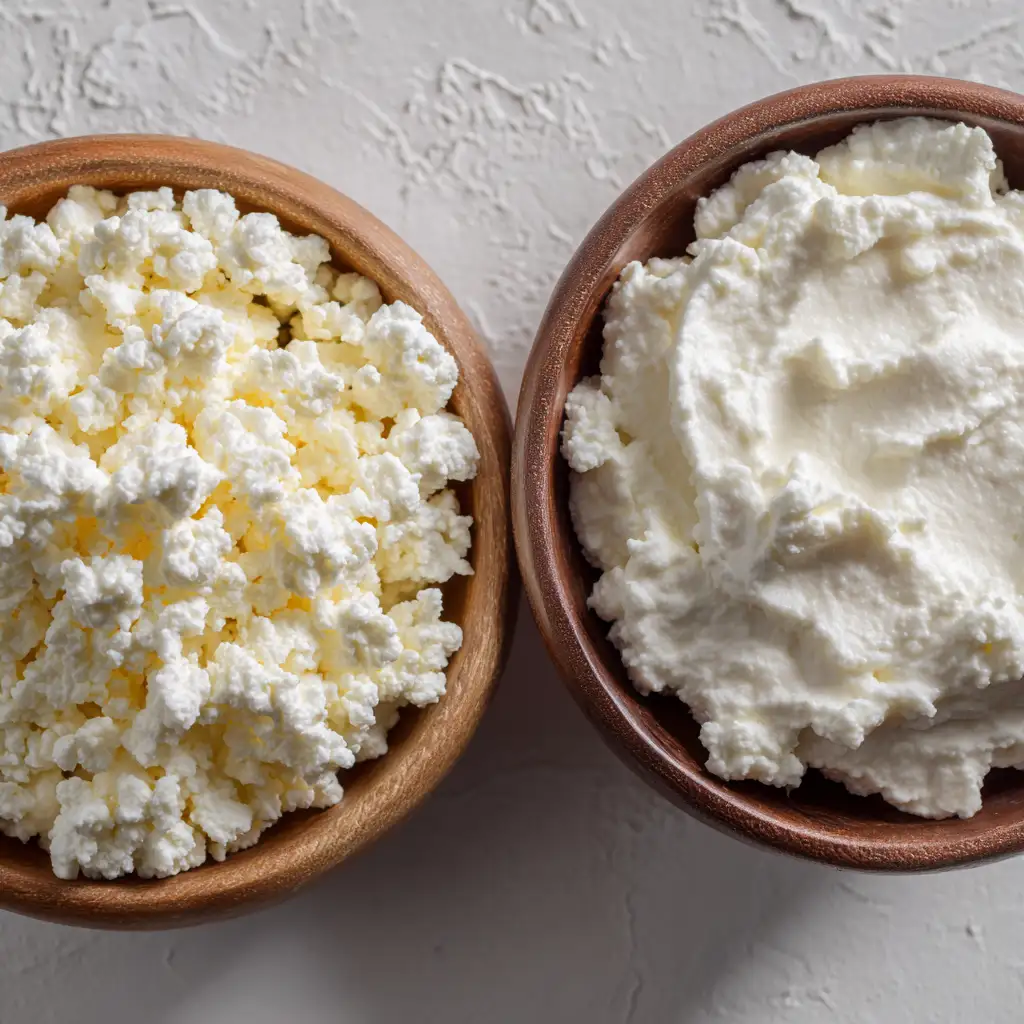
FAQ – Can I Make These Gluten-Free?
Yes – just swap in a 1:1 gluten-free flour blend. Because cottage cheese adds moisture, gluten-free versions actually turn out less crumbly than expected. Add ½ teaspoon xanthan gum or psyllium husk for better structure if your flour doesn’t already include it.
Protein-Powder Bagels (Max Protein, Up to ~19g)
If you want the most out of a bagel – we’re talking up to 19g protein per piece – adding protein powder is the way to go. But here’s the hard truth: do it wrong, and you’ll end up with dry, chalky rings that feel more like gym snacks than breakfast. The trick is choosing the right powder and adjusting the liquid to match.
Whey isolate tends to blend best, creating a dough that rises cleanly and bakes with a dense-but-chewy bite. Casein or plant-based blends work too, but they absorb more liquid – meaning you’ll need to tweak hydration carefully. Once dialed in, these protein bagels taste surprisingly close to the yogurt or cottage cheese versions, with the bonus of macros that rival a protein bar.
Step-by-Step Instructions (With Hydration Fixes)
- Mix dry base: Combine self-rising flour (or flour + baking powder + salt) with ¼–½ cup whey isolate. Start at the lower end – too much and the dough will seize.
- Add wet: Stir in Greek yogurt or blended cottage cheese (yes, you still need a binder). If dough feels too dry, add 1 teaspoon milk or water at a time.
- Shape: Roll into ropes, seal seams firmly. Expect the dough to feel slightly firmer than yogurt-only versions.
- Egg wash & toppings: Brush lightly; top with seeds or cheese.
- Bake or air fry:
- Oven: 375°F (190°C), 18–22 minutes. Look for deep golden tops.
- Air fryer: 300°F (150°C), 12–15 minutes. Flip halfway.
Pro tip: If the centers look gummy, drop the oven temp to 350°F (175°C) and extend bake by 5 minutes -low and slow fixes protein-heavy doughs.
FAQ – Which Protein Powder Works Best for Bagels?
Stick with a neutral, unflavored whey isolate for best results – it dissolves smoothly and won’t overpower the dough. Casein-heavy blends can make the crumb rubbery, while flavored powders often turn the bagels sweet or oddly artificial. If you want plant-based, pea protein works but requires more liquid.
Oven vs Air Fryer Protein Bagels (Times, Temps, Color Cues)
Once you’ve mixed your dough, the next big decision is how to bake: oven or air fryer? Both work beautifully, but the results aren’t identical. The oven delivers even, golden crusts with a more traditional bagel vibe. The air fryer? Faster, crispier, and great for small batches – but you’ll want to watch them closely to avoid over-browning.
If you’re cooking for the week, stick with the oven. If you’re in a hurry before work, the air fryer wins. The key is knowing what done actually looks like, so you don’t end up with pale tops or gummy centers.
Timing & Temperature Guide
| Method | Temp | Time | Visual Cues | Best For |
|---|---|---|---|---|
| Oven | 375°F (190°C) | 20–25 min | Even golden tops, firm bottoms | Larger batches, classic feel |
| Air Fryer | 300°F (150°C) | 14–18 min | Deep golden spots, crisp surface | Quick 2–4 bagels, crisp finish |
Tip: Flip bagels halfway in the air fryer for even browning. In the oven, rotate the tray once if your heat runs uneven.
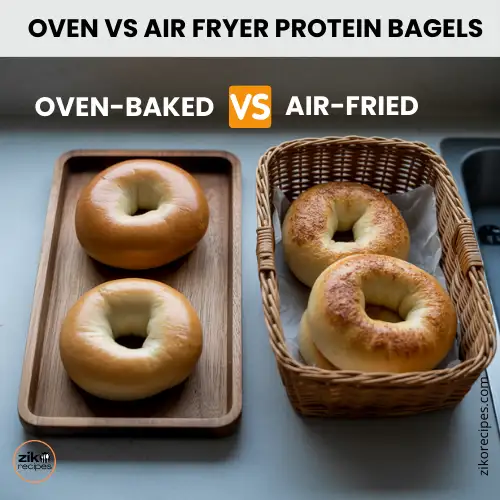
- Split image: one tray of oven-baked bagels vs air-fried bagels side by side.
- Close-up doneness cues: pale vs golden vs over-browned bagels.
- Optional: timing table graphic with clock icons for quick scanning.
FAQ – Which Is Better, Oven or Air Fryer for Protein Bagels?
It depends on your priorities. The oven gives you a more traditional bagel texture and handles big batches easily. The air fryer is faster, with crispier crusts, but works best for smaller amounts. Flavor-wise, they’re nearly identical – it’s all about texture and convenience.
Optional “Classic Chew” Upgrade (Yeast + Brief Boil)
Here’s the thing: as good as no-yeast bagels are, they’ll never have that classic, slightly elastic bite you get from a New York deli bagel. Why? Two steps – yeast fermentation and a quick boil – are what give traditional bagels their chew and glossy crust.
The good news? You don’t need an overnight rise or a bakery setup. A simple 45-minute proof and a 30–45 second boil per bagel (in water with baking soda or malt syrup) can take your protein bagels from “healthy bread rings” to something much closer to the real deal.
It’s an optional step – but if you’ve ever bitten into one and thought, “Hmm, missing something,” this is your fix.
Quick Yeast + Boil Method
- Add yeast to dough: Mix 1 tsp instant yeast into your flour base. Add a pinch of sugar to help it activate.
- Proof briefly: After mixing, cover the dough and let it rest 45 minutes until puffy.
- Shape & boil: Form rings, then drop each into simmering water with 1 tbsp baking soda (or malt syrup) for 30–45 seconds per side.
- Bake: Transfer to parchment, egg wash, and bake as usual. Bake time is the same, but the crust will be shinier and chewier.
Pro tip: Boiling too long makes bagels heavy and wrinkled. Stick to under a minute per side.

FAQ – Do You Need to Boil Protein Bagels?
No – you’ll still get tasty results without boiling. But boiling is what creates that iconic chewy crust. If you want your protein bagels to feel closer to a New York bagel, a short boil is worth the extra 5 minutes.
Troubleshooting Protein Bagels (Sticky, Dry, Dense, Gummy)
Let’s be real – the first batch of protein bagels doesn’t always go smoothly. Dough sticks to your hands, seams split in the oven, or worse… the inside bakes up gummy while the outside looks perfect. I’ve had all of those happen in my kitchen, and the good news is they’re fixable with a few simple tweaks.
Common Issues & Fixes
Sticky dough (won’t roll cleanly)
- Cause: Yogurt or cottage cheese too watery; flour not measured accurately.
- Fix: Strain yogurt/cottage cheese, or add 1–2 tbsp flour until dough firms up. Chill for 5 minutes before shaping.
Dry, crumbly dough (cracks while shaping)
- Cause: Too much protein powder or flour; yogurt not creamy enough.
- Fix: Add 1–2 tsp milk or water; knead lightly just until smooth.
Dense, heavy bagels (little rise, tough chew)
- Cause: Over-kneading; under-baking; no yeast for structure.
- Fix: Knead gently, bake fully (tops golden, bottoms firm), or try the yeast + boil upgrade for more lift.
Gummy centers (uncooked middle)
- Cause: Oven too hot, baking too short, or protein powder absorbing unevenly.
- Fix: Lower oven to 350°F (175°C) and extend bake by 5 minutes. Always cool at least 10 minutes before slicing — bagels keep cooking as they rest.
Pale tops (look underbaked even when done)
- Cause: Skipped egg wash or low oven heat.
- Fix: Always brush with egg; ensure oven is fully preheated.
FAQ – Why Are My Protein Bagels Gummy in the Middle?
Usually it’s a bake-time issue. Protein-heavy doughs brown faster on the outside, so the inside can lag behind. Lower the oven by 25°F and extend the bake 5–7 minutes, then let bagels cool before slicing. That resting time is what firms the centers.
Variations & Flavors (Sweet & Savory Protein Bagels)
The best part about homemade protein bagels is that once you’ve nailed the base, you can flavor them a hundred different ways. Think of the dough like a blank canvas: neutral enough for savory toppings, sturdy enough for sweet add-ins.
Here are some tried-and-true combinations that actually work (yes, I’ve tested them – some were… less successful):
Savory Protein Bagel Flavors
- Everything bagel seasoning: The classic. Garlic, onion, sesame, poppy seeds.
- Sesame or poppy seed: Clean, nutty finish.
- Asiago-jalapeño: Mix ¼ cup shredded cheese + a few jalapeño slices into the dough.
- Garlic-parmesan: Brush egg wash with garlic powder + parmesan for a cheesy crust.
Sweet Protein Bagel Flavors
- Cinnamon-raisin: Fold 2 tbsp raisins + ½ tsp cinnamon into dough.
- Blueberry: Fresh or frozen berries – press them in just before shaping.
- Chocolate chip: Use sugar-free chips for a macro-friendly treat.
- Vanilla glaze: Drizzle with a quick protein-powder glaze (whey isolate + almond milk).
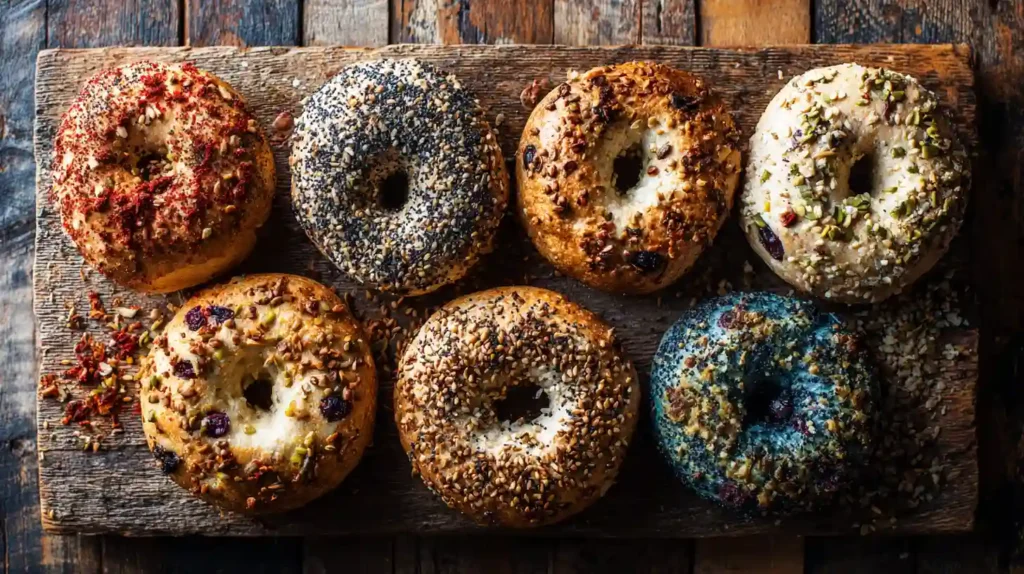
FAQ – Can I Add Flavors Directly into the Dough?
Yes, but do it wisely. Small, dry add-ins like cinnamon or raisins fold in easily. Wet ingredients (like fresh fruit) can make dough sticky, so press them in at the shaping stage instead. Cheese works well but lowers protein count slightly and may brown faster – keep an eye while baking.
Gluten-Free Protein Bagels (Tested Route)
If you’re gluten-sensitive or just experimenting with alternative flours, you can still enjoy protein bagels. The key is using the right gluten-free blend and giving the dough a little structural help. Without gluten, bagels risk turning crumbly – but cottage cheese or Greek yogurt provides natural moisture that actually helps GF doughs hold together better than most breads.
I’ve tested a few blends, and here’s what works best: a 1:1 gluten-free all-purpose mix that already includes xanthan gum. If your blend doesn’t, add ½ teaspoon xanthan gum or 1 teaspoon psyllium husk. These act like gluten stand-ins, creating stretch and chew.
Step-by-Step (Gluten-Free Adaptation)
- Flour swap: Replace wheat flour with equal weight gluten-free all-purpose blend.
- Mix gently: GF doughs can turn gummy if over-mixed. Stir just until combined.
- Hydration watch: Add yogurt or cottage cheese slowly – GF flours absorb differently. Dough should feel slightly tacky, not wet.
- Shape carefully: Roll between damp hands to prevent cracks.
- Bake as usual: Same oven and air fryer times apply – but keep an eye, as GF bagels brown faster on the edges.
FAQ – Do Gluten-Free Protein Bagels Taste Different?
A little. They’re usually lighter and slightly more crumbly, but the dairy base keeps them moist and flavorful. Toasting brings back chewiness, and with toppings or a sandwich filling, most people won’t notice the difference.
Storage, Freezing & Reheating (Meal Prep Playbook)
One of the biggest advantages of protein bagels is how well they fit into a meal-prep routine. Instead of rushing to bake daily, you can batch a dozen on Sunday and enjoy them for weeks with the right storage method. The trick is cooling, slicing, and wrapping them the smart way – otherwise, you’ll get freezer burn or soggy reheats.
How to Store Protein Bagels
- Room temp: Up to 2 days in a paper bag or bread box. They’ll stay soft but lose crust.
- Fridge: Not ideal – refrigeration dries bagels quickly. Use only if filled with perishable toppings (like cheese or meat).
How to Freeze for Long-Term
- Let bagels cool fully on a rack.
- Slice horizontally (so they can go straight into the toaster).
- Wrap each half in parchment, then place in a freezer-safe bag.
- Label with the date – they’ll stay best up to 30 days.
Reheating & Thawing
- Toaster: Straight from frozen, medium setting = crisp outside, soft inside.
- Air fryer: 300°F (150°C), 4–5 minutes for a fresh-baked feel.
- Oven: 350°F (175°C), 8–10 minutes if doing a big batch.
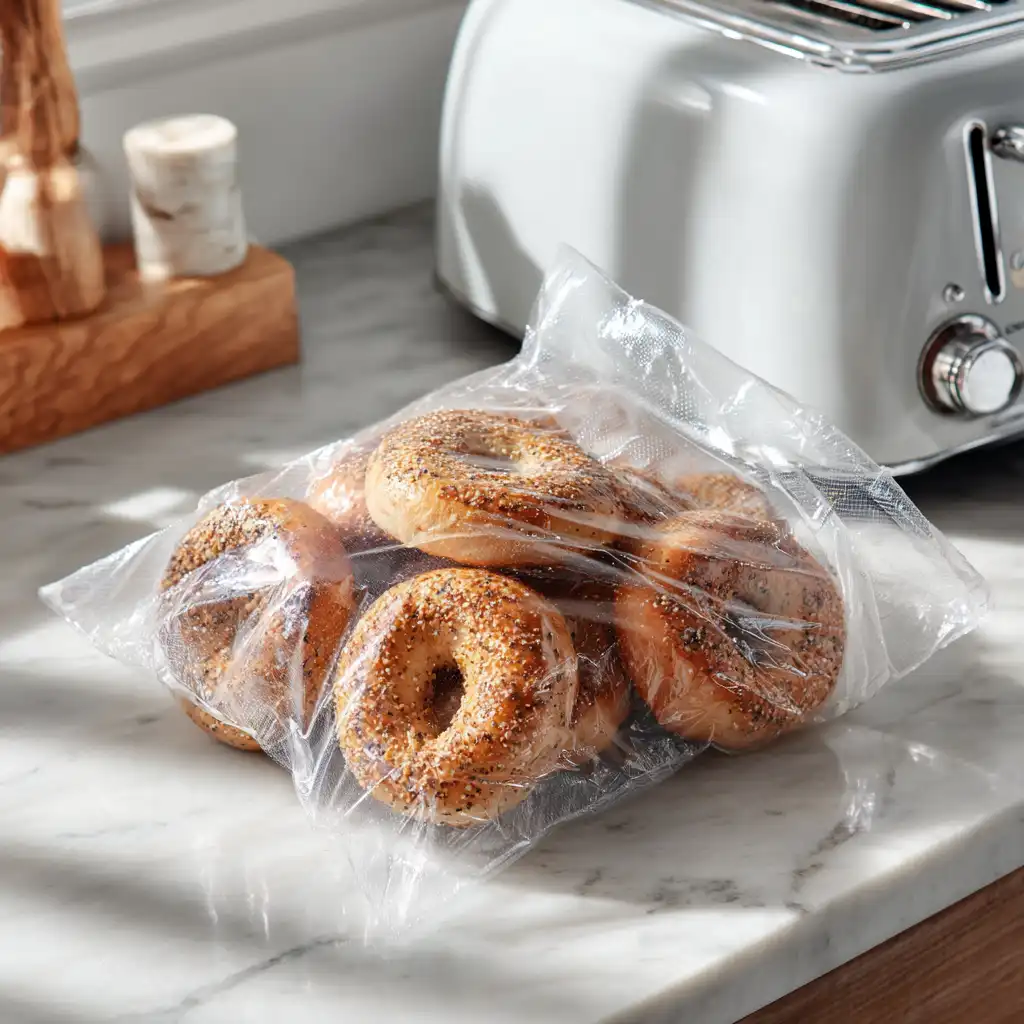
FAQ – Can You Freeze Protein Bagels?
Yes – in fact, they freeze better than most breads because the yogurt or cottage cheese keeps them moist. Always slice before freezing, so you can toast straight from frozen without thawing.
Protein Math & Healthy Serving Ideas
Here’s where protein bagels really shine: they’re a blank slate for stacking even more nutrition. A plain bagel might give you 10–19g protein depending on the version – but with smart toppings, you can easily build a 30–35g breakfast without feeling like you’re eating a protein bar in disguise.
Think of it as “protein math.” Start with the bagel’s base, then layer spreads and fillings that push the numbers higher while still tasting like a treat.
Savory High-Protein Combos
- Egg white & spinach sandwich: +12g protein
- Smoked salmon + light cream cheese: +15g protein
- Turkey breast + avocado: +20g protein, balanced fats
- Tuna salad (Greek yogurt base): +18g protein
Sweet High-Protein Combos
- Whipped cottage cheese + berries: +12g protein
- Peanut butter + sliced banana: +8g protein
- Protein-powder glaze + almond butter: +15g protein
- Chocolate hazelnut yogurt spread: +10g protein
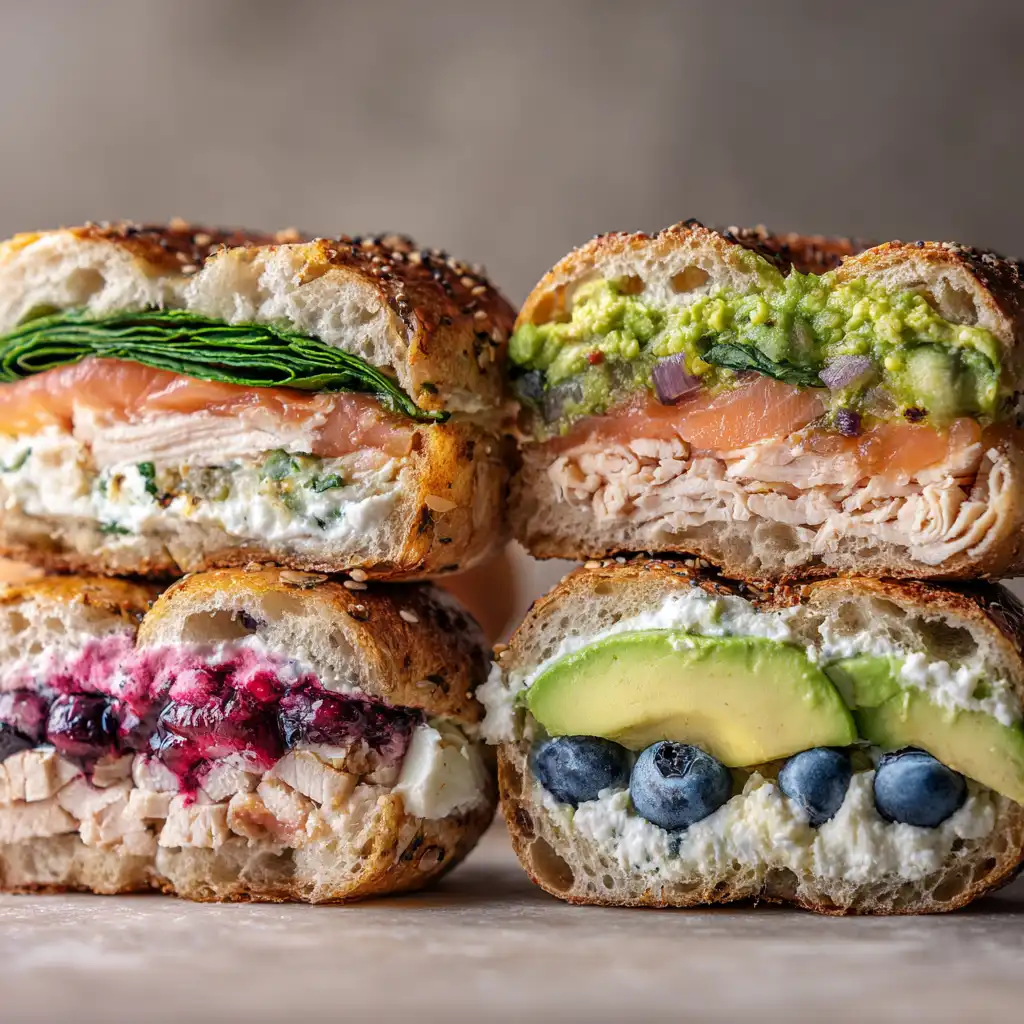
FAQ – How Many Calories Are in a Protein Bagel?
It depends on the version.
- Greek yogurt base: ~150–160 calories, 10–11g protein.
- Cottage cheese base: ~170–180 calories, 11–13g protein.
- Protein-powder base: ~190–220 calories, up to 19g protein.
Add toppings and fillings, and you can build anywhere from a 250-calorie snack to a 450-calorie meal.
FAQs About Protein Bagels
Yes – but with context. They’re higher in protein and lower in fat than traditional bagels, which makes them more filling and supportive of muscle recovery. That said, they’re still carbs at heart, so balance them with protein-rich toppings for best results.
Not necessarily. If you don’t have it, make your own by mixing 1 cup all-purpose flour + 1½ teaspoons baking powder + ¼ teaspoon salt. Works exactly the same.
Absolutely. Divide the dough into 8–10 pieces instead of 4, shorten baking by ~5 minutes (oven) or ~3 minutes (air fryer), and you’ll have bite-sized bagels perfect for snacks or meal prep.
Yes, but your bagels will bake up pale and toppings won’t stick as well. The egg wash doesn’t change flavor much – it’s mostly for looks and texture.
They’re close, but not identical. Traditional bagels are yeasted and boiled, which creates a chewier crust. Protein bagels are lighter and a bit tangier – especially the Greek yogurt version. Adding the yeast + boil step gets you closer to the real deal.

Protein Bagels (Greek Yogurt, Cottage Cheese & Whey Options)
Ingredients
Base Dough (choose one):
Greek Yogurt Bagels (classic shortcut)
- 1 cup 120g self-rising flour (or 1 cup AP flour + 1½ tsp baking powder + ¼ tsp salt)
- 1 cup 225g plain Greek yogurt (2% or whole milk works best)
- 1 egg beaten (for egg wash)
Cottage Cheese Bagels (ultra-tender)
- 1 cup 120g self-rising flour
- 1 cup 225g blended cottage cheese (strain if watery)
- 1 egg beaten (for egg wash)
Protein Powder Bagels (max protein)
- ¾ cup 90g self-rising flour
- ¼ cup 25g whey isolate (unflavored or neutral)
- 1 cup 225g Greek yogurt or blended cottage cheese
- 1 egg beaten (for egg wash)
Optional Toppings:
- Everything bagel seasoning
- Sesame or poppy seeds
- Shredded cheese Asiago, parmesan
- Cinnamon-sugar for sweet variation
Substitutions:
- Use Skyr instead of Greek yogurt for extra tang.
- Swap in 1:1 gluten-free flour blend with xanthan gum.
- Plant-based protein powders pea, soy work but need more liquid.
Instructions
- Mix Dry Ingredients: In a bowl, combine flour (and baking powder + salt if not using self-rising). Add whey isolate if making the protein powder version.
- Add Dairy Base: Stir in Greek yogurt or blended cottage cheese until dough clumps. Switch to hands and knead lightly (1–2 minutes). Dough should feel tacky, not sticky.
- Pro tip: If too sticky, dust with 1 tbsp flour. If too dry, add 1 tsp milk or water.
- Shape Bagels: Divide into 4 equal pieces. Roll each into a rope, pinch ends, and smooth seams to form rings.
- Egg Wash & Toppings: Brush with beaten egg. Sprinkle with seasoning, seeds, or cheese.
Bake or Air Fry:
- Oven: Preheat to 375°F (190°C). Bake 20–25 min until golden and firm.
- Air Fryer: Preheat to 300°F (150°C). Air fry 14–18 min, flipping halfway.
- Cool & Serve: Rest 10 minutes before slicing. Toast or fill as desired.
Notes
Nutrition Information (per bagel, Greek yogurt base – values vary by version)
SERVING: 95g | CALORIES: 165kcal | CARBOHYDRATES: 22g | PROTEIN: 11g | FAT: 4g | SATURATED FAT: 1g | CHOLESTEROL: 40mg | SODIUM: 290mg | POTASSIUM: 115mg | FIBER: 1g | SUGAR: 2g | VITAMIN A: 65iu | VITAMIN C: 0mg | CALCIUM: 85mg | IRON: 1.2mg (Cottage cheese base: ~180kcal, 12–13g protein; Whey version: ~200kcal, up to 19g protein.)Price of Recipe
- Total cost: ~$6 for 4 bagels ($1.50 per bagel)
- Flour: $1
- Greek yogurt or cottage cheese: $3
- Egg + toppings: $2
Recipe Notes
- Ingredient swaps: Skyr for yogurt; pea protein for whey; dairy-free yogurt for vegan option (with plant protein powder).
- Storage: 2 days room temp (paper bag), 1 month freezer (pre-slice & wrap). Toast straight from frozen.
- Variations: Sweet (cinnamon-raisin, blueberry) or savory (asiago-jalapeño, garlic-parmesan).
- Troubleshooting: Sticky dough? Add flour. Dry dough? Add 1 tsp liquid. Gummy center? Lower oven 25°F and extend bake.
- Diet: High Protein, Meal Prep, Optional Gluten-Free
Call-to-Action
Did you try this protein bagel recipe? Leave a rating, share it with friends, and let me know in the comments which version you picked – Greek yogurt, cottage cheese, or whey-boosted!Want a printable-style plan? Go to the High-Protein Breakfast guide.
Conclusion – Pick Your Path, Hit Your Protein
At the end of the day, the “best” protein bagel isn’t one-size-fits-all – it’s the one that fits your mornings. Maybe it’s the quick-and-tangy Greek yogurt version, the ultra-tender cottage cheese upgrade, or the whey-powered bagel that doubles as a post-workout boost. Whatever path you choose, you’ve now got a playbook that takes you from sticky dough frustrations to golden, freezer-friendly wins.
If you give these a try, I’d love to hear how they turned out for you. Did you go classic, fluffy, or max-protein? Drop a comment, leave a rating, and don’t forget you can print or save the recipe for later.
And if you’re a meal-prep lover who lives on inspiration boards – pin this recipe to your Pinterest so it’s waiting the next time your carb cravings hit. Sharing on Instagram or Facebook? Tag me so I can see your bagel creations (and probably get hungry all over again).
For more breakfast fuel, check out my other high-protein recipes – because once you master these bagels, you’ll realize healthy mornings don’t have to feel like a compromise.
